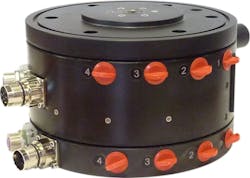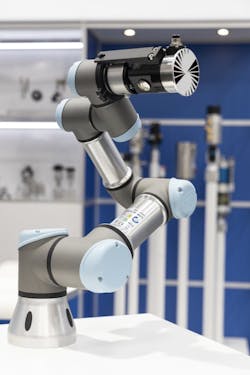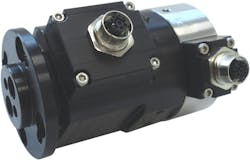An automobile, on average, has 3,500 fasteners consisting of nuts, bolts, clamps, screws and more. The material for these fasteners ranges from zinc-coated metal to vinyl. After reviewing its production process, an automaker’s R&D department decided to automate how its workers used electric hand tools to turn plastic screws for fastening certain vehicle body parts.
Automating the process would bring consistency and efficiency, reduce errors and eliminate injuries from repetitive motion. To turn each plastic screw without stripping the fastener’s threads and keep pace with the vehicle production line, the automaker’s R&D team determined the car maker would need a robot with a tooling end that could rotate 360 deg., monitor torque continuously and communicate via PROFINET. The solution would have to offer seamless, continuous rotation at the joint of the robot’s tool interface.
READ MORE: Driving Robotics and Embedded Motion Applications with Next-Generation Servo Technology
“There appeared to be no supplier on the market that could meet the requirements to enable the process,” recalls Martin Assmann, marketing manager for Moog GAT in Geisenheim, Germany. “The R&D team then made an inquiry to us, and we made the process possible with an ultra-light combination slip ring and rotary union, which we call Rotokombi.”
According to Assmann, the customized solution for the automaker required high-performance motion-control, which called for a specific kind of technology. By way of background, a slip ring is an electromechanical device that allows the transmission of power and electrical signals from a stationary to a rotating structure. Inside the slip ring, brushes provide electrical contact between the rotating ring and the assembly’s stationary parts. The brushes ride on the ring and the brush block assembly mounts on the stationary structure.
The slip ring portion of the solution Moog GAT supplied is critical for not only the transmission of power but also monitoring torque, since there must be an unbroken exchange of data between the tool end of the robot arm and its control unit. Unlike the carbon brushes found in many slip rings, the slip ring Moog GAT chose for this application combines gold spring wire and gold-plated slip tracks. Assmann said this gold-gold technology extends the slip ring’s service life, drastically reduces any maintenance and ensures high signal quality.
READ MORE: Force Control Brings Dexterity and Sensitivity to Adaptive Robots
Paired with the slip ring is a Moog rotary union, which can accommodate up to eight channels. For this application, the rotary union includes two channels through which the automaker’s robot can transmit air to create a vacuum up to 10 bar for holding and releasing the plastic screws. Moog GAT rotary unions can also transfer media such as oil, water and gas.
“About 85% of our solutions are customized with the client,” Assmann adds. “Any application requiring 360-deg. rotation will need a slip ring and/or a rotary union.”
As for choosing a robotic arm, the automaker’s R&D team tapped Universal Robots’ UR3e, the smallest industrial collaborative robot arm in the company’s portfolio. The UR3e can lift no more than 3 kg., so Moog developed a Rotokombi weighing 1 kg. The UR3e robot arm, which has a reach of 500 millimeters, relies on the Rotokombi to guide each screw using a vacuum and a calibrated control loop that automatically halts the tightening process upon reaching the maximum torque, providing precision and control to the process.
READ MORE: Universal Robots’ Latest Cobot is Redesigned for Palletizing
According to Moog GAT’s engineers, the customized solution is entirely new. Moog’s team worked with Universal Robot and the automaker’s R&D team to design and assemble the 1-kg rotary union and slip ring, which transmits power, signals and data to the tool end. The ultra-lightweight Rotokombi developed for the automaker’s fastener-turning application stands in contrast to other such units that Moog GAT has developed for applications like sheet metal rolling and tunnel boring; for some of these applications, engineers have designed and manufactured Rotokombis weighing up to 4,000 kg.
Once the current test phase ends for the robotic screwdriver, the automaker’s R&D department foresees using seven UR3e robots with lightweight Rotokombi. The robots will be affixed on automated trolleys for the induction loops of the production line to screw together various body parts.
This application story was submitted by Bill Perry, managing partner, MARCH 24 Media LLC.



